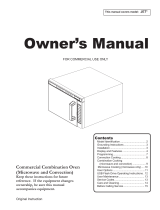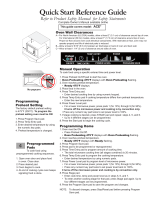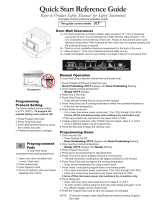Amana UACE5302 is a commercial-grade combination oven offering both microwave and convection cooking capabilities. With its ability to cook food quickly and evenly, it's perfect for busy kitchens that need to produce high-quality dishes efficiently. The microwave function allows for rapid heating and defrosting, while the convection feature ensures crispy and evenly browned results. Additionally, the combination mode combines the benefits of both microwave and convection cooking, reducing cooking time while maintaining food quality.
Amana UACE5302 is a commercial-grade combination oven offering both microwave and convection cooking capabilities. With its ability to cook food quickly and evenly, it's perfect for busy kitchens that need to produce high-quality dishes efficiently. The microwave function allows for rapid heating and defrosting, while the convection feature ensures crispy and evenly browned results. Additionally, the combination mode combines the benefits of both microwave and convection cooking, reducing cooking time while maintaining food quality.















-
 1
1
-
 2
2
-
 3
3
-
 4
4
-
 5
5
-
 6
6
-
 7
7
-
 8
8
-
 9
9
-
 10
10
-
 11
11
-
 12
12
-
 13
13
-
 14
14
-
 15
15
Amana UACE530 Operating instructions
- Category
- Microwaves
- Type
- Operating instructions
Amana UACE5302 is a commercial-grade combination oven offering both microwave and convection cooking capabilities. With its ability to cook food quickly and evenly, it's perfect for busy kitchens that need to produce high-quality dishes efficiently. The microwave function allows for rapid heating and defrosting, while the convection feature ensures crispy and evenly browned results. Additionally, the combination mode combines the benefits of both microwave and convection cooking, reducing cooking time while maintaining food quality.
Ask a question and I''ll find the answer in the document
Finding information in a document is now easier with AI
Related papers
Other documents
-
Hendi 281369 User manual
-
 Menumaster CR855 Owner's manual
Menumaster CR855 Owner's manual
-
ACP ACE Series Owner's manual
-
ACP Heavy Duty Commercial Compact Microwave Oven Owner's manual
-
ACP Heavy Duty Commercial Compact Microwave Oven Owner's manual
-
 Menumaster ACE Series Quick Start & Reference Manual
Menumaster ACE Series Quick Start & Reference Manual
-
 Menumaster ACE Series Quick Start & Reference Manual
Menumaster ACE Series Quick Start & Reference Manual
-
Menumaster Heavy Duty Commercial Compact Microwave Oven Owner's manual
-
 Menumaster ACE Series Quick Start & Reference Manual
Menumaster ACE Series Quick Start & Reference Manual
-
ACP Heavy Duty Commercial Compact Microwave Oven Owner's manual


















